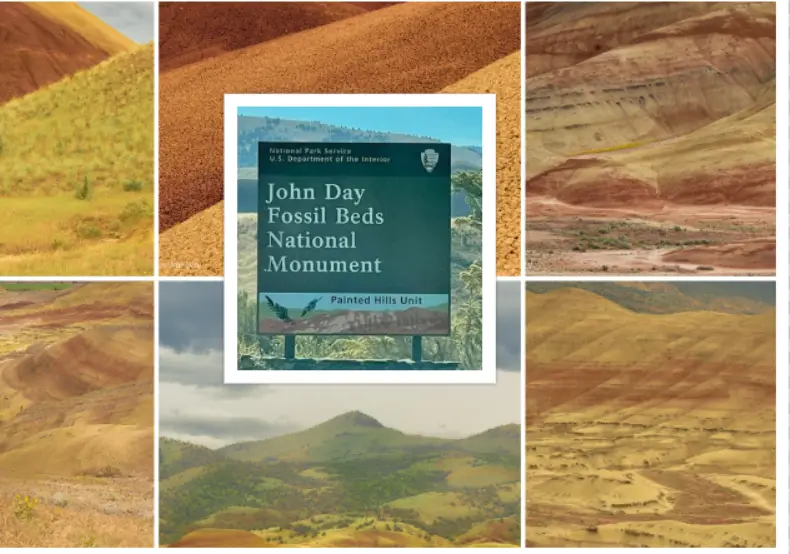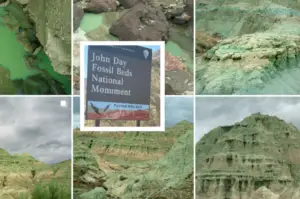John Day Fossil Beds : Interesting Facts, History & Travel Guide

- By
- Aparna Patel
- |
- 11 Apr, 2023
- |

John Day Fossil Beds National Monument is a stunning geological site located in eastern Oregon, USA. This incredible natural wonder offers a glimpse into the region’s ancient past, showcasing a rich diversity of plant and animal life that lived millions of years ago. With its incredible fossil record, scenic landscapes, and fascinating history, the monument is a must-visit destination for nature lovers and history buffs alike.
In this blog post, we will delve into the interesting facts and history of John Day Fossil Beds National Monument, as well as provide a comprehensive travel guide to help visitors plan their trip to this incredible destination.
Table of Contents
Interesting facts about John Day Fossil Beds National Monument
- The monument is located in eastern Oregon, USA, and consists of three separate units: the Sheep Rock, Painted Hills, and Clarno units.
- John Day Fossil Beds National Monument is named after John Day, a member of the 1811 Astor Expedition who is said to have been separated from his party and wandered into the area where the monument is now located.
- The monument is known for its incredible fossil record, which spans over 40 million years of history. Fossils found in the area include ancient horses, camels, and rhinoceroses, as well as numerous species of plants and insects.
- The park is home to some of the most well-preserved and complete mammal fossils from the Cenozoic Era, which began about 65 million years ago and continues to the present day.
- The monument covers a total area of over 14,000 acres and offers visitors a range of recreational opportunities, including hiking, camping, and wildlife viewing.
- The Painted Hills unit of the monument is particularly known for its strikingly colorful hills, which are the result of volcanic activity and erosion over millions of years.
- The monument is also home to a number of cultural sites, including the Cant Ranch Historic District, which features a ranch house, barn, and other buildings that date back to the early 20th century.
- The monument was established in 1975 and is managed by the National Park Service, which works to protect and preserve the area’s unique natural and cultural resources for future generations to enjoy.
History of John Day Fossil Beds National Monument
The history of John Day Fossil Beds National Monument dates back millions of years, to a time when the region was home to a diverse array of plants and animals. Over time, the area was buried by volcanic ash and sediment, which helped to preserve the remains of these ancient organisms.
The first human inhabitants of the region were likely Native American tribes, who used the area for hunting and gathering for thousands of years. In more recent times, the region became an important center for cattle ranching and other agricultural activities.
In the late 19th and early 20th centuries, scientists began to take an interest in the fossils found in the region. Paleontologist John C. Merriam conducted some of the earliest scientific studies of the area, and he was instrumental in convincing Congress to establish the John Day Fossil Beds National Monument in 1975.
Today, the monument is recognized as one of the most important fossil sites in North America, and it continues to attract researchers and visitors from around the world. The National Park Service works to protect and preserve the area’s unique natural and cultural resources, while also providing opportunities for recreation and education.
Read More:
- Jewel Cave National Monument : Interesting Facts, History & Travel Guide
- Ironwood Forest National Monument : Interesting Facts, History & Travel Guide
- Hovenweep National Monument : Interesting Facts, History & Travel Guide
- Hohokam Pima National Monument : Interesting Facts, History & Travel Guide
- Harriet Tubman Underground Railroad National Monument : Interesting Facts, History & Travel Guide
Travel Guide for John Day Fossil Beds National Monument
Location: The monument is located in eastern Oregon, USA, and consists of three separate units: the Sheep Rock, Painted Hills, and Clarno units. The closest major city is Bend, Oregon, which is about a two-hour drive from the monument.
When to visit: The monument is open year-round, but the best time to visit is during the spring and fall, when temperatures are mild and the weather is generally dry. Summers can be hot and dry, while winters can be cold and snowy.
Getting there: The monument is accessible by car, and there are several scenic driving routes that lead to the different units. The nearest airports are in Bend and Portland, Oregon, which are both about a 2-3 hour drive from the monument.
Activities: The monument offers a range of recreational opportunities, including hiking, camping, and wildlife viewing. Each unit has its own trails and facilities, and visitors can also participate in ranger-led programs and guided tours.
Attractions: The main attraction of the monument is its incredible fossil record, which spans over 40 million years of history. The monument’s three units offer different perspectives on this history, with the Sheep Rock Unit featuring the Thomas Condon Paleontology Center, the Painted Hills Unit showcasing colorful hills and geological formations, and the Clarno Unit featuring towering rock formations and petroglyphs.
Services: Each unit of the monument offers visitor centers with information on the area’s geology, ecology, and cultural history. Camping facilities are available in the Sheep Rock and Painted Hills units, and there are also several picnic areas throughout the monument.
Tips: Be sure to bring plenty of water and sunscreen, as the monument can be hot and dry during the summer months. Also, be aware that the roads leading to the different units may be unpaved and rugged, so it’s best to check road conditions before heading out.
By following this travel guide, visitors can experience the natural beauty and rich history of John Day Fossil Beds National Monument while enjoying a range of recreational activities and educational opportunities.
John Day Fossil Beds National monument camping
Camping is a popular activity at John Day Fossil Beds National Monument, allowing visitors to fully immerse themselves in the natural beauty of the area. The monument offers two campgrounds: the Clyde Holliday State Recreation Site and the Mascall Overlook Campground.
The Clyde Holliday State Recreation Site is located in the Sheep Rock Unit of the monument and offers 31 RV and tent sites with electric and water hookups, as well as restrooms, showers, and a dump station. The campground is open year-round and reservations can be made online.
The Mascall Overlook Campground is located in the Clarno Unit of the monument and offers 14 primitive campsites with stunning views of the surrounding landscape. The campground is first-come, first-served and has no water or restroom facilities, so visitors should come prepared with their own supplies.
Both campgrounds offer a peaceful and secluded camping experience, surrounded by beautiful natural scenery and plenty of opportunities for hiking, wildlife watching, and stargazing. However, visitors should be aware that the campgrounds can get busy during peak season, so it’s best to book early or arrive early in the day to secure a spot.
In addition to the campgrounds within the monument, there are also several private campgrounds and RV parks located nearby, offering additional amenities and services for visitors. Whether you prefer roughing it in a tent or enjoying the comforts of an RV, John Day Fossil Beds National Monument has plenty of options for camping and enjoying the beauty of this incredible natural wonder.
More Article
- Hanford Reach National Monument : Interesting Facts, History & Travel Guide
- Hagerman Fossil Beds National Monument : Interesting Facts, History & Travel Guide
- Grand Staircase–Escalante National Monument : Interesting Facts, History & Travel Guide
- Grand Portage National Monument : Interesting Facts, History & Travel Guide
Search Posts
Latest posts
-
5 Mar, 2024
Passing through airport security with autism
-
5 Mar, 2024
Why prohibit engine braking?
-
4 Mar, 2024
How to make dining alone less awkward?
Popular posts
-
5 Mar, 2024
Why prohibit engine braking?
